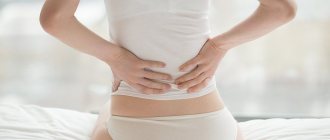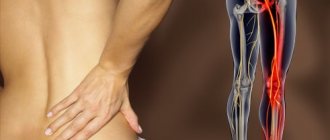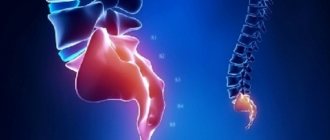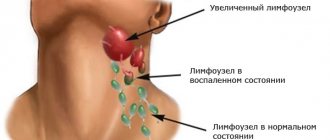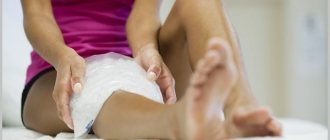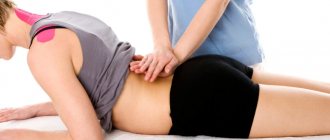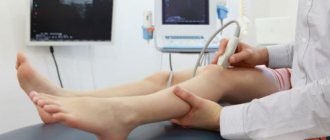Causes of back pain above the lower back
Back pain is a very common symptom. Therefore, when there is pain in the back, above or below the lower back, differential diagnosis comes to the fore. This is a diagnostic search process, the goal of which is to exclude dozens of diseases and establish the exact cause of the pain syndrome. To do this, a thorough examination of the patient is carried out, laboratory and instrumental diagnostic methods are used. This is the only way to accurately establish a diagnosis and prescribe appropriate treatment.
Osteochondrosis
Osteochondrosis is degenerative changes in the strong but elastic connective (cartilaginous) tissue of the intervertebral discs, which cushion and compensate for the load on the spine. The cause of the disease is a sedentary and sedentary lifestyle, lack of physical activity, and genetic predisposition. Malnutrition leads to drying out of the cartilage, loss of moisture, and a decrease in the height of the intervertebral discs. The spine loses its ability to support body weight, which is why the main load falls on the intervertebral joints and back muscles. As a result, the joints become inflamed, degenerative phenomena also occur in them, spasm of the back muscles occurs, and chronic aching and shooting pains in the back appear, which are concentrated above or below the lower back, depending on which part of the spine is affected the most.
Shpidonov Gennady Stanislavovich
Neurologist
Rostov State Medical University (neurology)
10 years of experience
Muscle inflammation
Myositis, or muscle inflammation, is a common cause of back pain, especially in the lower back, on either side of the spine, where the powerful muscles that support and stabilize the spinal column are located. The cause of inflammation can be intense physical activity, drafts and local hypothermia. But more often, myositis is a concomitant symptom of osteochondrosis, herniated intervertebral discs, scoliosis, arthritis and arthrosis of the intervertebral joints. Inflammation occurs as a response to overstrain and spasm of the muscles, which have to withstand increased loads caused by a problem with the spine. The nature of the pain is aching, sudden movements can provoke increased pain.
Spinal hernia
Intervertebral hernia is a complication of spinal osteochondrosis that occurs when the integrity of the intervertebral discs is damaged. Normally, the intervertebral disc plays the role of a shock absorber, absorbing and distributing loads on the spinal column. To do this, it has a strong peripheral part in the form of a ring of dense connective tissue, and inside the disc, under pressure, there is an aqueous core. Osteochondrosis leads to drying out of the fibrous ring, which loses moisture and strength. When moving or lifting weights, the pressure inside the disc increases sharply, which leads to rupture of the peripheral part of the intervertebral disc. Through the gap, fragments of the disc nucleus enter the spinal canal, forming a hernial protrusion.
Depending on the location of the hernia and its volume, pinching of the spinal cord roots is possible, which is manifested by severe sharp shooting pains in the spine, often radiating to other parts of the body. A characteristic symptom is a forced position with a forward bend, which reduces the pressure in the affected intervertebral disc. Back pain, localized above or below the lower back, can be paroxysmal in nature, intensifying when standing, lifting weights, or moving.
Diseases of the kidneys, liver, pancreas
Back pain just above the lower back may be a symptom of kidney, liver or pancreas disease. The reason is that the internal organs also have sensory nerve fibers that are part of the spinal cord roots. In case of inflammatory, oncological and other pathologies of these organs, pain impulses first enter the spinal cord, from where they are redirected to the central nervous system. However, some impulses may get lost, causing them to be mistakenly perceived by the brain as back pain.
Shpidonov Gennady Stanislavovich
Neurologist
Rostov State Medical University (neurology)
10 years of experience
Also, back pain due to diseases of the internal organs can be direct in nature, associated with the spread of inflammation or a tumor process to the deep muscles of the back. This is observed with abscesses of the tissue surrounding the kidneys and with tumors of the pancreas. The pain can be of a different nature and depends on the underlying disease.
Gynecological diseases
Aching pain in the back above the lower back can be a symptom of gynecological diseases. The pain is referred in nature and occurs with inflammatory pathologies of the pelvic organs, such as adnexitis, salpingoophoritis, endometriosis, uterine fibroids (with large tumor sizes). A similar picture can occur with malignant tumors of the cervix, uterus and its appendages.
Age-related changes
With age, the spine undergoes a number of changes that negatively affect the flexibility of the spinal column and its ability to withstand loads. The ligamentous apparatus, muscles, and bone tissue undergo changes. Degenerative changes in the intervertebral discs and joints lead to osteochondrosis and arthrosis - destruction of cartilage tissue, sclerotic changes. The muscles undergo atrophy, which is why they lose the ability to stabilize and support the spine and bear some of the loads. Ligaments lose elasticity and flexibility, which, together with other changes, causes spinal instability. Bone tissue loses mineralization, which leads to osteoporosis. Pain is caused by a complex of changes characteristic of older people and can be of a very different nature.
Manifestations during pregnancy
Pain in the back above the lower back, in the lower back and sacrum is a common symptom during pregnancy. And there are several explanations for this:
- The growing uterus shifts the center of gravity, leads to posterior deviation of the lumbosacral spine, emphasizes the natural curves and increases their curvature, which changes the biomechanics of the spinal column, increases the load on its joints, ligaments, muscles and intervertebral discs;
- An increase in body weight leads to an additional increase in the load on the spine and back muscles;
- Deficiency of calcium, necessary for the formation of the child’s skeleton, leads to a decrease in the mineralization of the bones of the spine;
- Female sex hormones reduce the density of connective tissue, leading to higher mobility of the semi-mobile joints of the pelvic ring, increasing the extensibility of ligaments and muscles, which also increases the load on the back.
The above changes provoke back pain, which can also intensify in the presence of existing spinal diseases.
Diseases of internal organs
Diseases of the urinary system, kidneys, liver, intestines, and biliary tract can also be accompanied by pain in the back and spine, in the area above or below the lower back. The nature of the pain depends on the diagnosis, the severity of the disease, and the extent of pathological changes. This symptom is observed in liver cirrhosis, inflammatory diseases of the biliary tract, gallstones, tumors of internal organs, intestinal pathologies (Crohn's disease, ulcerative colitis).
Shpidonov Gennady Stanislavovich
Neurologist
Rostov State Medical University (neurology)
10 years of experience
Symptom of discopathy
Intervertebral disc disease, commonly known as disc disease, is the most common source of lower back pain on the upper sides.
The discs consist of hard pulmonary nuclei and surrounding elastic rings. They are located between the vertebrae, and their function is to distribute and absorb the loads to which the spine is subjected. Beginning in adolescence, disc degeneration, called discopathy, progresses with age. When we overload the spine, the rings can rupture and the nuclei of the disc pulps are pushed back or fall out (disc prolapse), causing extreme pain. In this case, treatment of the back and spine, as well as joints, is mandatory.
A prolapsed disc causes sudden, severe pain that usually goes away when you lie down. The patient also involuntarily tilts in the opposite direction of the displaced disc, which slightly reduces discomfort - that is, when the disc falls to the right, the patient tilts to the left.
Unilateral pain in the lumbar region (in the back on the right or left) can be caused by diseases of the urinary system, especially kidney stones. Manifestations of renal colic can be:
- irradiation of pain to the groin, labia or testicles, inner thigh;
- nausea, vomiting;
- urge to urinate;
- frequent urination in small quantities;
- hematuria (sometimes).
When a urinary tract infection (nephritis) occurs after a kidney stone, fever and chills are added. There is a Goldflam symptom, that is, pain in the kidney area on the side of colic. Pain in the side and right side of the back can also be caused by enlarged cysts in the right kidney and kidney tumors.
Types of back pain above the lower back
The nature of the pain may have diagnostic value and may help in making a preliminary diagnosis.
| Girdle pain | Girdle pain is characteristic of intercostal neuralgia, inflammation of the pancreas, intervertebral hernia, and rib fractures. |
| It's a dull pain | Aching pain is observed with myositis, scoliosis, pregnancy, and diseases of the internal organs. |
| Nagging pain | Nagging pain is diagnosed in gynecological pathologies, kidney diseases, and gallstones. |
| Blunt pain | Dull pain is a symptom characteristic of bruises, cirrhosis of the liver, and pathological muscle spasm. |
| Sharp pain | Sharp back pain can occur with osteochondrosis of the spine, with hernias and protrusions of intervertebral discs, compression fractures of the spine, and age-related changes. |
| Continuous pain | Severe constant pain is a sign of radicular syndrome, which occurs when spinal nerves are pinched, acute inflammation of the intervertebral disc (discitis), spinal cord tumor, or osteoporosis. |
Who's hurting?
You can understand what exactly is bothering you by the nature of the sensations. Taking into account a number of nuances, the doctor can make a fairly accurate diagnosis at the appointment. But the patient will still be sent for examination to confirm or refute the doctor’s verdict. Diagnostics provide new information about the patient’s health status. At the first consultation, the nature of the pain is taken into account:
- A nagging pain on the left side above the lower back often signals the likelihood of pyelonephritis. The pain is dull and not very pronounced.
- If the pain in the left side behind above the lower back is acute, it may be colic or spasm due to urolithiasis.
- When the kidneys become inflamed, irritation occurs, which manifests itself in constant pain. They can be confused with pain in the lower back.
- When the source of problems is in the middle, then the problems are most likely in the spine. In this case, it can radiate to the lower extremities.
- If the sensations intensify with movement, then it may be radiculitis or osteochondrosis.
It is important not to make mistakes when carrying out diagnostics and to correctly determine the location of unpleasant sensations and the nature of the ailment. In this case, it will be possible to make a fairly accurate diagnosis at a preliminary appointment.
Treatment of back pain above the lumbar region
To treat pain in diseases of the spine, various methods are used - drug treatment, vitamin therapy, physical therapy (conservative therapy). It is important that treatment is received in full, in combination with all available means. In the absence of effect from conservative therapy or in the presence of serious complications, surgical treatment is used.
Vitamins
Vitamin therapy helps improve the nutrition of intervertebral discs and joints, stimulates the formation of collagen and the regeneration of cartilage tissue. Vitamins are important in metabolism, acting as a factor vital for the synthesis of hormones, enzymes and proteins.
Physiotherapeutic treatment
Physiotherapy uses physical factors such as heat, electric current, laser radiation, electromagnetic radiation to improve microcirculation, correct metabolic disorders, eliminate inflammatory reactions, regenerate soft tissues of the spine, and combat pathological muscle spasms. Physiotherapy can also be used to administer medications (anti-inflammatory, absorbent and painkillers) using current (electrophoresis) or ultrasound (ultraphonophoresis).
Shpidonov Gennady Stanislavovich
Neurologist
Rostov State Medical University (neurology)
10 years of experience
Traditional treatment
There are many methods for treating pain from the back, above or below the lumbar region, using traditional medicine. To do this, a variety of means and methods are used - from bee stings to regular visits to the bathhouse. Traditional medicine can improve metabolism, relieve inflammation and pain, and stimulate independent recovery of a diseased spine. Traditional medicine can serve as an additional or auxiliary method of treatment, but before using it, you must always consult a doctor. The reason is that many techniques can be strictly contraindicated for diseases such as spinal tuberculosis, tumors and metastases in the spine, as well as for diseases of the cardiovascular system and internal organs.
Herbal treatment
There are many medicines based on the use of plant materials and recognized by official medicine. Thus, many drugs for the treatment of heart disease are based on alkaloids isolated from herbs. The disadvantages of herbal medicine are the lack of proven effectiveness for a particular pathology, the risk of side effects and allergic reactions, and the high probability of falling into the hands of swindlers and charlatans.
Homeopathy
Homeopathy, or the method of treating various diseases using microdoses of various substances, is an alternative direction of unofficial medicine. The basis of homeopathy is the doctrine of treating like with like, which arose in the 17th century. The effectiveness of homeopathy is questioned by official medicine, which has been repeatedly proven in research. Many homeopathic remedies can be harmful and even fatal. But the most important negative effect of this technique is that the patient wastes time and money on useless treatment. If back pain is caused by a serious illness, infatuation with homeopathy can lead to irreparable harm to health, complications and late seeking medical help.
Surgery
Surgical treatment of spinal diseases is used in the absence of effect from conservative therapy, as well as in case of serious complications requiring emergency intervention. There are many different surgical techniques aimed at removing intervertebral hernias, stabilizing the spine, correcting scoliotic curvature, restoring the integrity of the bones of the spinal column in case of fractures, etc. For some diseases and complications, surgery is the only possible method of treatment.
Prevention: how to avoid problems
To prevent your back from bothering you, you need to keep your body in good physical shape and monitor the health of all internal organs. Problems arise for a variety of reasons - from age to those related to an unhealthy lifestyle. It is recommended to strengthen the muscle corset so that it supports the spinal column in the correct position.
An active lifestyle and proper nutrition will help eliminate the main risks of diseases of the internal organs. In addition, regular exercise will keep the spine in perfect condition, keeping it youthful.
It is necessary to undergo regular examination at the clinic. It is better to make sure that you are healthy than to live in ignorance. Most problems could be solved at an early stage, when the disease is invisible. To maintain kidney health, it is recommended to give up bad habits, eat right, and dress for the weather.
Diagnosis of back pain above the lumbar region
The primary diagnosis of the causes of back pain is carried out at an appointment with a neurologist. A thorough examination and questioning of the patient allows us to detect symptoms and signs characteristic of a particular pathology. Magnetic resonance imaging is ideal to confirm the diagnosis. This is the safest and most accurate diagnostic method, based on the use of magnetic fields and radio waves to obtain accurate, detailed images of the spine and other organs and tissues of the human body. MRI can be used not only to diagnose back diseases - the technique allows you to diagnose diseases of the abdominal and pelvic organs, which can lead to pain in the spine.
Diagnostics
When a patient is admitted with complaints in the back area, he should immediately undergo a series of hardware tests:
- ECG. It is necessary not only for diagnosing possible pathologies of the cardiac system, but also for assessing the condition of the whole organism. This information will help the specialist, for example, if it is necessary to perform an urgent operation.
- X-ray of the spine and lungs. This hardware examination allows us to detect not only injuries to these parts of the body, but also a number of diseases of the respiratory system, for example, tuberculosis. If you have a cough, it would be useful to do a sputum test to find out which pathogen is the causative agent of the disease.
- MRI and CT. Despite the fact that these diagnostic methods are considered optimal for assessing the condition of the back, internal organs and blood vessels, during emergency admission they are performed infrequently, which is explained by the poor equipment of many medical institutions.
- Extensive blood and urine tests. They give a more complete picture of the state of the body as a whole. Some deviations from the norm may direct the specialist to the next stage of diagnosing the patient. For example, if protein is detected in the urine, we can talk about renal pathology and further refer the patient for ultrasound of the kidneys and other research methods.
- Coprogram. It is prescribed when a specialist suspects disorders in the digestive tract.
A device for conducting electrocardiography must be available to specialists who receive patients admitted urgently. The procedure takes a couple of minutes, and the doctor receives the results almost immediately
Further therapeutic tactics will depend on the results of the study. Some diseases can be treated extremely quickly, while others will require months of painstaking collaboration between the attending physician and the patient.
First aid for back pain above the waist
Rest, painkillers, dry heat and limiting physical activity with heavy lifting are the first aid for back pain. Bed rest helps relieve the sore spine, relieve pressure on the spinal cord roots, and relieve pain. Painkillers relieve swelling and inflammation, which are the source of pain. Limiting physical activity helps prevent further damage to the affected spine. Dry heat helps relieve muscle spasms and pain, improves microcirculation.
The most important thing for back pain is not to delay visiting a doctor. Only consultation with a specialist and examination can determine the cause of the pain syndrome. Without diagnosis, any treatment may not only not help, but also cause harm to health.
Shpidonov Gennady Stanislavovich
Neurologist
Rostov State Medical University (neurology)
10 years of experience
